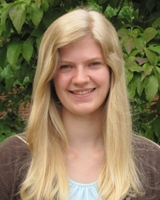2013 REU Program Participant Profiles: Kiersten Utsey

|
Major: Mathematics and Biology |
Why did you apply to the REU program?
I applied to the NIMBioS REU because I hoped it would enable me to pursue my interest in mathematical modeling as well as apply and develop my research skills. I participated in another excellent REU program last summer, and had heard good reviews of this program. I hoped the REU could prove invaluable in broadening my research background and exposing me to opportunities in applied math.
How did you hear about the program?
My college math advisor knew about the program and suggested I apply as a sophomore. Although I participated in another REU program the summer after sophomore year, I was still interested in the NIMBioS program. I attended the NIMBioS Undergraduate Research Conference the fall of my junior year. This was a wonderful experience, and after the conference, I knew I wanted to apply for the NIMBioS REU program.
What is the purpose of your research?
We are using a computer program called Mathematica to create interactive synthetic fetal electrocardiogram (ECG) signals. ECG's essentially trace the electric currents that initiate the heartbeat, and they can be used to diagnose possible heart disorders. Fetal ECG's are measured by placing electrodes on the abdomen of the mother. However, both the fetal and the maternal signals are recorded, and this signal is contaminated with noise from fetal brain activity, muscle signals, and movement. As such, current fetal ECGs cannot be accurately estimated. We are generating a database of fetal ECG signals with varying sampling frequencies and noise levels. Algorithms designed to extract the fetal signal can then be tested on the database to determine to performance of each test. This performance assessment may then be used to help clinicians understand which biomedical signaling processing techniques are best for a given situation.
What does the research ultimately accomplish? What contributions to science and/or humanity does the research ultimately make?
By creating a synthetic database of fetal ECG signals, other researchers can test the effectiveness of algorithms that extract the fetal ECG signal. This performance testing can then help clinicians determine which biomedical signaling processing techniques are best for a given application. A more accurate fetal ECG signal can help clinicians then identify possible fetal heart disorders and prevent birth defect-related deaths.
Tell us something about your field of study we would be surprised to know. Mathematical biology is much more useful than you may think! Although often overlooked, math is the core of much modern biological research. Math can be used to better understand everything from DNA synthesis to environmental conservation. As technology advances math becomes more and more important in research.
What were your favorite parts of the REU program?
The opportunity to work and collaborate with so many people interested in mathematical biology has been incredible. I attend a small, liberal arts college with few mathematicians and even fewer mathematical biologists, so it has been especially enjoyable meeting and working with so many like-minded individuals.
What new experiences did you gain that have helped you today?
Independent research has been the most valuable experience I've gained. The opportunity to work on a problem, try new ideas, learn new mathematics and biology, and overcome roadblocks is invaluable. I'm confident my experiences this summer will be important as I transition into graduate school.
NIMBioS
1122 Volunteer Blvd., Suite 106
University of Tennessee
Knoxville,
TN 37996-3410
PH: (865) 974-9334
FAX: (865) 974-9461
Contact NIMBioS


